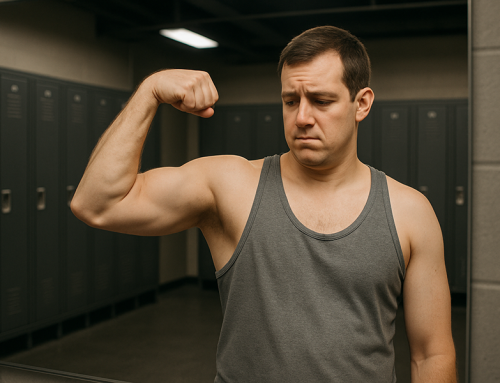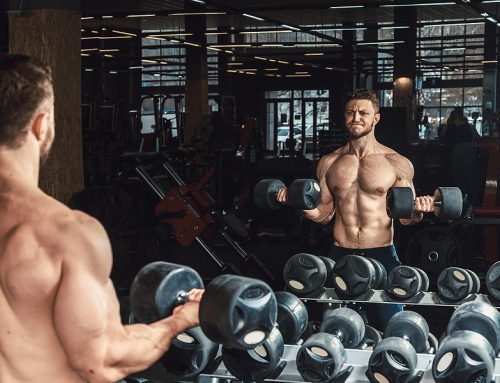Is a full body workout better than a split routine? There are lots of trainers who promote full body lifting. Some claim full body workouts are superior for building muscle. A lot of them say they’re better for burning fat. No doubt, full body workouts can be effective for either goal. Full body workouts also suit a lot of people’s schedules and personal preferences. That doesn’t mean a full body workout is always better for everyone. In some cases, for some goals, split routines are the far better choice. In the case of fat loss, the answer can be nuanced. In today’s Burn the Fat Blog Q & A, I explain everything…
Q: Hi Tom, I’m going on vacation in two months so I’ve been tightening up my Burn the Fat, Feed the Muscle efforts so I can get as lean as possible in that amount of time. I started on the three days a week full body primer workout from your book, then went to your T.N.B. 28 program (2-day split). My question is, I know some people split routines even more, like the 3 way push-pull-legs split, and that’s supposed to be more advanced, but I’ve been hearing trainers say that full body workouts using compound exercises are better for fat loss. If that’s true, I’m thinking of switching back to a full body routine and making it as “metabolic” as possible. So is it true? If so, how much difference do you think it will make?
A: No it’s not true that a full body workout is always better than a split routine for fat loss. I know a lot of trainers make this claim, and full body training can often be a good choice. But there are too many variables to make such a blanket statement about superiority. Usually when someone promotes full body workouts for fat loss, it also involves some kind of fast-paced lifting or lifting mixed with cardio. (Essentially circuit training). This is said to be more “metabolic,” meaning that it’s supposed to burn more calories and be more cardiovascularly stimulating.

But even if this were true, the split or training schedule isn’t the main factor that dictates fat loss. Plus, if you try to turn your weight training into cardio training, your weight training becomes a lot less effective for building strength and muscle. That’s a compromise you may or may not want to make.
What’s Really Most Important For Fat Loss
Whether you do a full body routine or a split routine is not the most important weight training variable that influences fat loss. Other factors like the choice of exercise and especially the total work volume are far more impactful.
Furthermore, weight training is not even the most important factor in the overall fat loss equation. Even though weight training is vital in a fat loss program for maintaining muscle, your diet is the main priority for burning fat. When you want to accelerate fat loss, changes to your diet will give you a bigger bang for your buck than changes to weight training.
What I’m saying is that if you like it, and it’s working, you could keep the same lifting routine you’re on now (a 2 day split done 4 days a week) or you could advance to a 3-day push-pull-legs split (5-days a week). You can get the extra fat loss you want the fastest and most efficiently simply by tightening up your diet. Specifically, you would make sure you have a calorie deficit and even increase your deficit slightly.
If you don’t want to increase your deficit by reducing food intake, then you could still keep a split routine for weight training and increase the volume of cardio training you’re doing. That would also be more efficient than trying to change your lifting routine to get more fat loss, because cardio burns more calories than traditional weight training.
How Tweaking Weight Training Programs Might Help With Fat Loss
To a lesser degree, yes you could get some fat loss benefit from changing certain lifting variables.
What trainers sometimes suggest to help boost fat loss is trying to make weight lifting produce a more “metabolic” effect. Usually that means shorter rest intervals or circuit training, combined with spending the majority of your lifting time on compound exercises.
Exercise selection can definitely make a difference. This might mean focusing on squats and lunges instead of leg extensions and leg curls, presses instead of flyes and lateral raises, and deadlifts and rows instead of isolation back exercises and bicep curls. These compound exercises are considered more “metabolic” because they’re harder, they involve a larger area of muscle mass, you can lift more weight and they burn more calories.
As far as the exercise choice goes, regardless of whether you do a full body workout or a split routine, and regardless of whether your goal is burning or building, it’s never a bad idea to focus on the big compound exercises first, especially when you don’t have a lot of time to train. And yes, those moves like squats and lunges and deadlifts are certainly more metabolically stimulating and calorie-burning than calf raises and bicep curls.
That doesn’t mean isolation exercises aren’t helpful or you should avoid them. (I’m not giving up my curls!) Studies clearly show that isolation exercises added in addition to compound exercises when time permits will help increase overall muscle growth even further. They also can help you develop different sections of a muscle more completely. Choosing compound exercises first is more about prioritizing when you have limited time.
What About “Metabolic” Weight Training And Circuit Training?
What a lot of people do when trying to make a full body weight training workout more “metabolic” is to not only choose compound exercises, but also decrease rest periods between sets or even switch to circuit training.
Sometimes, they’ll do cardio or calisthenic exercises between sets of weight lifting. Either way, the resistance exercises are done with minimal rest periods, and sometimes virtually nonstop. This makes the workout more cardiovascular for sure.
The problem is, if you cut down your rest intervals or switch to circuit training, you have to cut the amount of weight you lift because you aren’t recovering in between sets. Essentially what you’ve done is turn your weight training into cardio training. Then it’s not traditional weight training anymore, so it’s not nearly as effective for building and maintaining muscle.
The worst case scenario is that in trying to make your lifting more like cardio, you end up actually losing strength and muscle. (Or at least, compromising your gains).
If building or maintaining muscle and strength are important to you, it’s arguably better to stick with traditional weight training parameters and use your diet plus some cardio (separately) to increase your fat loss.
The Truth About Weight Training And Calorie Burning
Here’s what a lot of people don’t consider: Research has found that weight training, even with compound exercises, really doesn’t burn that many calories, at least compared to continuous and fairly vigorous cardio.
A recent study published in the scientific journal, Medicine and Science in Sports and Exercise created a new equation for estimating calorie expenditure during lifting. It found that the average burn from a lifting session was only 100 to 300 calories. That’s a lot less than what people think they’re burning! This was based on using a fairly traditional full body routine with 3 sets of 8 to 12 reps and 90 seconds rest between each set.
Previous studies have shown that typical weight training workouts burn as little as 65 calories to as many as 540 calories. The wide range is due to differences in total exercise volume, duration and intensity, as well as the type of exercise, and length of rest intervals. It’s usually in the lower end of this range. Typically, only big guys doing a ton of volume (long workouts with lots of sets) will hit the upper end of that range.
Ok, but what if you could somehow tweak your weight training style to get the calorie burn from the low end of that range to the high end? Wouldn’t that help with fat loss? Yes, it is possible. But lifting is still unlikely to burn as much as vigorous cardio. And there’s no shortcut. If you think you’re burning a ton of calories with a very brief, low-volume workout, even if it’s intense (like resistance training HIIT), you’re only fooling yourself. You may be burning more calories per minute, but still not that many in total.
Also, you don’t control all the variables that influence how much you burn. It can depend on age, gender, body weight and lean body mass. Short, petite women simply aren’t going to burn that many calories, so dietary diligence is the real key.
Research shows that the training variable you control that affects your total calorie burn the most is the amount of work you perform. It’s not about the number of reps or sets alone, but specifically, the volume load (that’s sets X reps X weight).
The calorie burn you get from from lifting is also not necessarily a matter of whether you’re on a full body routine, a 2-day split routine or a body part split routine like the ones bodybuilders use. Granted, if you’re training big muscles like legs and back at every workout, you’re going to be burning more than you would if you just had an arm day. But full body workouts vs split routines isn’t what determines fat loss. Calorie deficit is.
Fat Loss Hinges Upon Calorie Deficit, Not Lifting
You can achieve a calorie deficit most efficiently first by manipulating diet, second by adding cardio, and only third in order of priority, changing your lifting style or schedule.
Look at it this way: A recent study of successful competitive bodybuilders found that 100% of them used body part split routines. Some used 2 day splits, some 3 day splits, some “bro splits.” But not a single one used full body workouts, and bodybuilders are the leanest athletes in the world.
If full body circuit training is ideal for fat loss, then why don’t the best physique athletes train that way? It’s because their weight training programs are designed specifically to build aesthetic muscle or, when dieting, to maintain as much muscle as possible. What gets them ripped is their strict diet and adding some cardio on top of the lifting.
What I’m suggesting is that if fat loss is not your only goal, and you also want to develop your strength and physique, then trying to turn your weight training into a “metabolic” cardio-type of workout is actually less effective given your goals. What most people should do instead is look at weight training as a muscle-building, muscle-shaping, and muscle-maintaining tool, and look at diet and cardio as the fat loss tools.
Lots of people try to make their weight training routines better for fat loss but end up shooting themselves in the foot. They accidentally make their lifting less effective for building muscle and strength and may or may not get better fat loss in the process.
Here’s another example of this: A lot of people figure that doing higher reps will help increase fat loss. It’s possible it might if it increased the total volume of training or the total calories burned. But when you change to lighter weights and higher reps, unless you train really hard to failure, you may end up burning fewer calories because lifting light weights is easier. Also, lighter lifting is always less effective for building strength and usually less effective for building muscle.
For all these reasons, you really have to analyze your personal goals and preferences before making a decision to change your lifting purely for the sake of fat loss. If building strength is one of your goals, then switching to high reps is not the best strategy. Neither is switching completely to circuits or “metabolic” lifting workouts.
When physique and muscle and strength are priorities, you would be best to keep your weight training in the traditional format. Sometimes a change in training split or schedule is good simply for variety’s sake. But either way, this means taking normal rest periods between sets (usually one to two minutes), and doing most of your sets in the 6 to 12 rep range taken close to failure (with only a small portion of your reps being higher for certain exercises).
When Full Body “Metabolic” Training Makes Sense
With all this said, I wouldn’t want to disparage or discourage people who choose circuit training, or “metabolic” types of weight training. I’m only suggesting that you need to make sure this style of training aligns with your goals, and you really enjoy it. Also, it should be your choice, not something a trainer dictated.
There is a major advantage you can get from using short rest intervals and doing circuit training and that’s time efficiency. You may not get the workout that gives you the maximum amount of strength and muscle gain, but if maximum strength and muscle gain is not your priority, and you don’t have a lot of time, then these styles of training can be a very good choice and any compromise is worth it.
Some people also find fast paced training is more enjoyable and engaging as well. I know people who hate sitting around two minutes between each set of lifting – they want to keep moving and keep doing something, or else they’re bored out of their minds.
If time efficiency and engaging workouts are your priority, and if general fitness, conditioning and fat loss are your goals, not maximum strength and muscle mass, then full body metabolic lifting or circuit training could be a great choice. Just don’t forget that fat loss will still be a function of calorie deficit, not your lifting style, so diet will still have to be on point.
As they say, you can’t out-train a bad diet. That goes for lifting as well as cardio. Trainers who promote “fat-burning” weight training programs are right to include lifting, but often misrepresent the degree that weight training contributes to fat loss.
Even though the fitness industry is full of promises saying otherwise, you rarely get more by doing less. There are some exceptions, like if you find a way to squeeze more volume in less time. You might be able to achieve that with circuit training (but you will sacrifice strength gains).
Even Better Than Circuit Training? …
Another way you can achieve that, which I believe is even better, is with superset training. And if you use the antagonist type of superset, you not only get more work done in less time, the research shows that you don’t compromise strength or muscle in the process. Antagonist superset training is one of the few proven techniques to get more from less. (Not less volume, but more results from less time spent).
This is the reason I so often recommend antagonist superset training above circuit training.
My T.N.B. TURBO program is based entirely on this training principle. The technique is effective for strength, muscle gain, and helping with fat loss. The biggest benefit is time efficiency. You can cut your workout time by one-third to one-half using this training style and still build the same amount of muscle and strength, or even more.
CLICK HERE to visit the TNB TURBO Training page.
The Bottom Line:
Changing weight training workouts to full body training may or may not increase fat loss. If you change from split routines to full body training and your total weekly volume goes down, you will actually burn fewer calories and the schedule change doesn’t help fat loss.
Remember, bodybuilders and physique athletes use body part split routines almost exclusively and they are among the most ripped athletes on the planet. More than any tweaks to lifting, it’s their diet that gets them there.
Train hard and expect success,
Tom Venuto,
Founder of, Burn the Fat Inner Circle
Author of Burn the Fat, Feed the Muscle
Author of The BFFM Guide to Flexible Meal Planning For Fat Loss

Tom Venuto is a natural bodybuilding and fat loss expert. He is also a recipe creator specializing in fat-burning, muscle-building cooking. Tom is a former competitive bodybuilder and today works as a full-time fitness coach, writer, blogger, and author. In his spare time, he is an avid outdoor enthusiast and backpacker. His book, Burn The Fat, Feed The Muscle is an international bestseller, first as an ebook and now as a hardcover and audiobook. The Body Fat Solution, Tom’s book about emotional eating and long-term weight maintenance, was an Oprah Magazine and Men’s Fitness Magazine pick. Tom is also the founder of Burn The Fat Inner Circle – a fitness support community with over 52,000 members worldwide since 2006. Click here for membership details







Leave A Comment